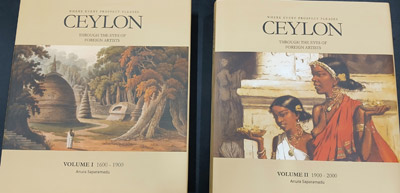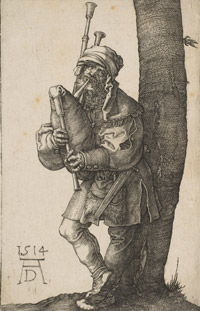Foreign artists’ gaze of our island over 5 centuries
Bringing together the works of 420 foreign artists whose paintings reflect the landscape and people of Sri Lanka, Anura Saparamadu’s latest book, a project which he has been labouring over for 13 years, is ‘Ceylon — Through the eyes of Foreign Artists’. In two sumptuously illustrated volumes numbering some 900 pages, the artists’ works spanning over five centuries from 1500-2000 are examined.
The book faithfully records the work of artists from 17 European countries and includes those from America, Australia, and New Zealand, and Asian artists from India, China, Japan and Malaysia. In contrast to many previous publications, the work of many professional artists is also recorded.
 The plates exhibit the sharply contrasting techniques employed by the artists. A dazzling array of techniques – oils, water colours, crayons, mixed media, engravings, etchings, lithographs, pen and ink and pencil sketches as well as artistic movements from the early 19th century to the early 21stcentury are well represented.
The plates exhibit the sharply contrasting techniques employed by the artists. A dazzling array of techniques – oils, water colours, crayons, mixed media, engravings, etchings, lithographs, pen and ink and pencil sketches as well as artistic movements from the early 19th century to the early 21stcentury are well represented.
Broadly speaking, the work of artists depicted in the two volumes can be roughly classified into five categories. The first looks at artists of the colonial period whose work such as engravings and paintings were executed in Sri Lanka between the 16-19th century. The majority of these artists were officials employed by the military and civil administrations, among them personalities such as Cornelis Steiger, Pieter de Brever, William Willerman and Thomas Lyttleton.
The second category is the handful of artists such as Henri Salt and Herman von Königsbrunn who visited this country accompanying their patrons who were often from the aristocracy or Royalty.
The third category was artists who were invited to undertake official visits to Ceylon, such as Wolfgang Heydt, Roland Vivian Pitchford and D.H. Floyd.
Then comes the works of artists who were here on a personal capacity, among them Samuel Daniel, Marianne North, Constance Cummings and Otaka Nejedley whose primary purpose was to discover subject matter which they would make annotated sketches of, to be later turned into paintings. Often, they would direct their finished work to a particular type of patron. By the late 19th and early 20th century, their numbers were quite considerable.

Durer: ‘The bagpipe player’
The final group was those who enjoyed the ‘Ceylonese experience’ through writings and descriptions by others who visited the island. They painted landscapes, people and events from their own imagination and based on drawings, sketches and notes sent from the island. Some of the better-known of this group were Andre Reynoso, Copley Fielding James Stephanoff and William Daniel.
Also, in this category are the works of some world-renowned artists such as Albert Durer (1471-1525), Rembrandt van Rijn (1606-1679), Andre Reynoso (1590-1641) and Auguste Ingres (1780-1867) whose sketches represented subjects related to Sri Lanka.
A fascinating example is Durer’s woodcut ‘The bagpipe player’ – a design executed in 1518 which was later featured in an ivory casket carved by craftsmen in Sri Lanka. Most probably a copy of the engraving by Durer was passed on by the administrators in Goa and incorporated in the external face of the design of an ivory casket with silver hinges and gold filigree work set with a sapphire gem stone.
This exquisite piece was sent as a token of friendship by King Bhuvaneka Bahu to the Portuguese Queen Catherine in Lisbon via Dom Joao de Castro. It was recorded in an inventory of 1550-1552.
Also, in the same class is the masterpiece by the famous Portuguese Renaissance painter Andre Reynoso (1590-1641) titled “Saint Francis Xavier restores to life a native of Ceylon”. Executed around 1619, the oil painting depicts one of the miracles attributed to Francis Xavier – the burial at Mannar of a young man who comes to life after the saint’s blessing.
Twenty paintings on a similar theme dedicated to the evangelical callings of Francis Xavier are at the Church of Saint Roch, in Lisbon, Portugal.
Such exchanges in the art world of the Orient and the Occident were not uncommon at the time between Asia and Europe. There is the portrait of the first British Governor Frederick North (1766-1827) by Ingres and the sketch of the elephant called Hanksen.
This female elephant born in 1630 was exported from Sri Lanka to Europe. It was presented by the Dutch authorities to Prince Fredrick Henry in 1633. Later Hanksen was sent as a gift to the Vatican and paraded across Europe, being exhibited in several capital cities. It is likely that Rembrandt encountered the pachyderm when it was brought to Amsterdam in 1637, and made an elaborate sketch, probably one of the most accurate depictions of this species at the time. This sketch was later incorporated in an etching composed in 1638 in the work Adam and Eve in Paradise.
Also featured in the book are the German artists during the Second World War whose works only came to light only recently. Their work was censored and later confiscated by the Nazi regime during the Second World War. Several artists went into exile and some turned up in Sri Lanka.
In a similar vein also included are the works of Russian art at its zenith – here too one can observe how over the years when the state exerted control over artists, censorship was rife and the art movements swiftly collapsed.
The author has not neglected the contribution by women artists. Among the impressive works by talented artists and designers of stained glass, is a rare stained glass window done by Florence Camm (1865-1930) for a Methodist church in Colombo. Whether it was ever installed in that church in Colombo is still uncertain.
Among the English artists featured, there are rare works by writers and poets including J.B. Priestly who worked in water colours while relaxing in this country. Another writer mentioned is Duncan Grant, who married Vanessa Bell, sister of the famed novelist Virginia Woolf.
In the list of famous contemporary American artists, we have examples of the art of Rauschenberg who visited in Colombo in 1980. I still recollect meeting him and discussing the works of art he did here to be offered to the National Museum, Colombo. What happened to these very valuable works of art is still a mystery!
Anura has followed in the footsteps of his father Sanath Saparamadu whom I had the opportunity to collaborate with on some of the publications his publishing company Tisara Prakasakayo published in the 1970s and 1980s.
The two volume set of ‘Ceylon- Through the eyes of Foreign Artists’ priced at Rs. 75,000 is published by W.L.H. Skeen, Dehiwala. For inquiries, contact tel/ WhatsApp: +94773860086
Searching for an ideal partner? Find your soul mate on Hitad.lk, Sri Lanka's favourite marriage proposals page. With Hitad.lk matrimonial advertisements you have access to thousands of ads from potential suitors who are looking for someone just like you.


